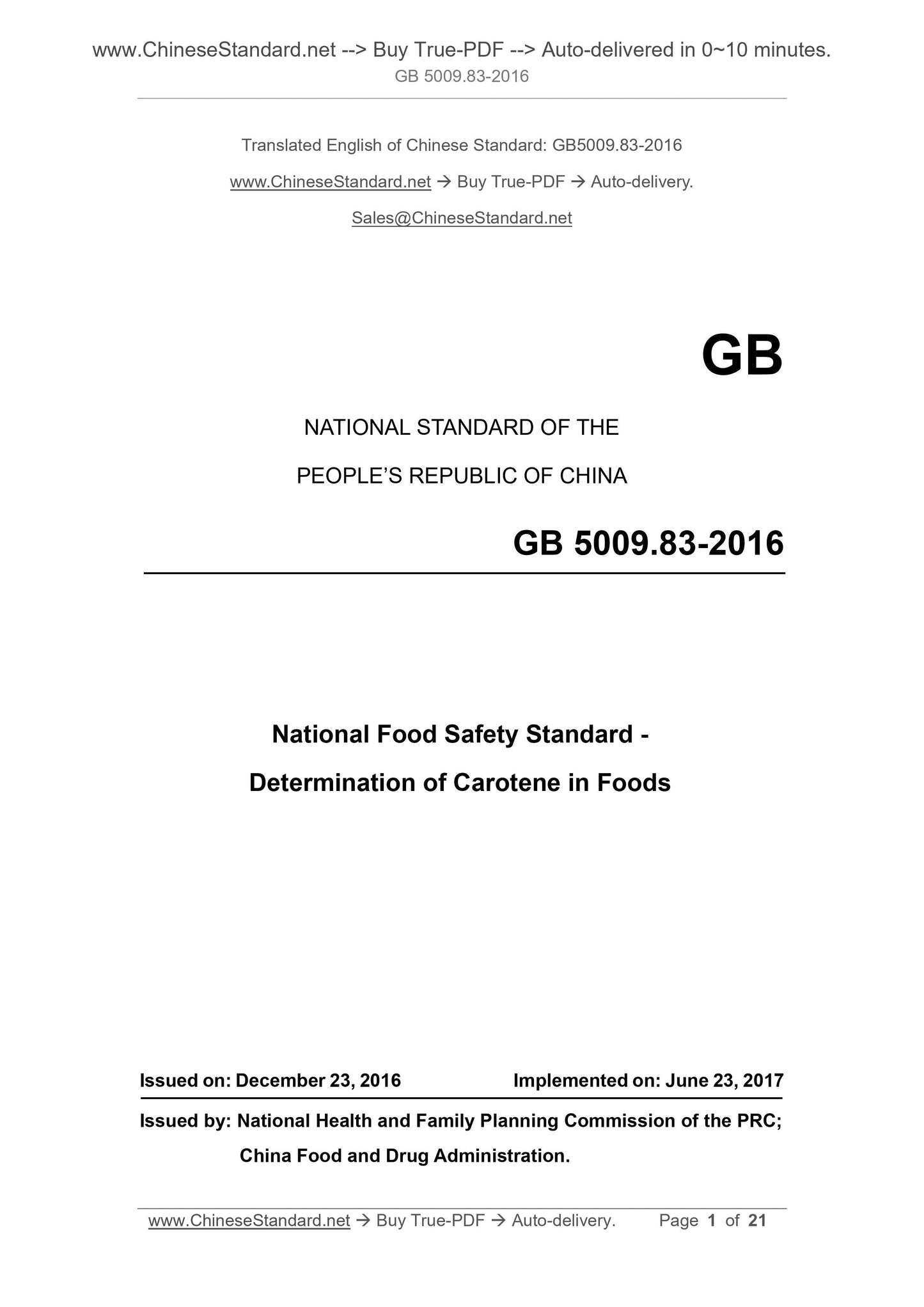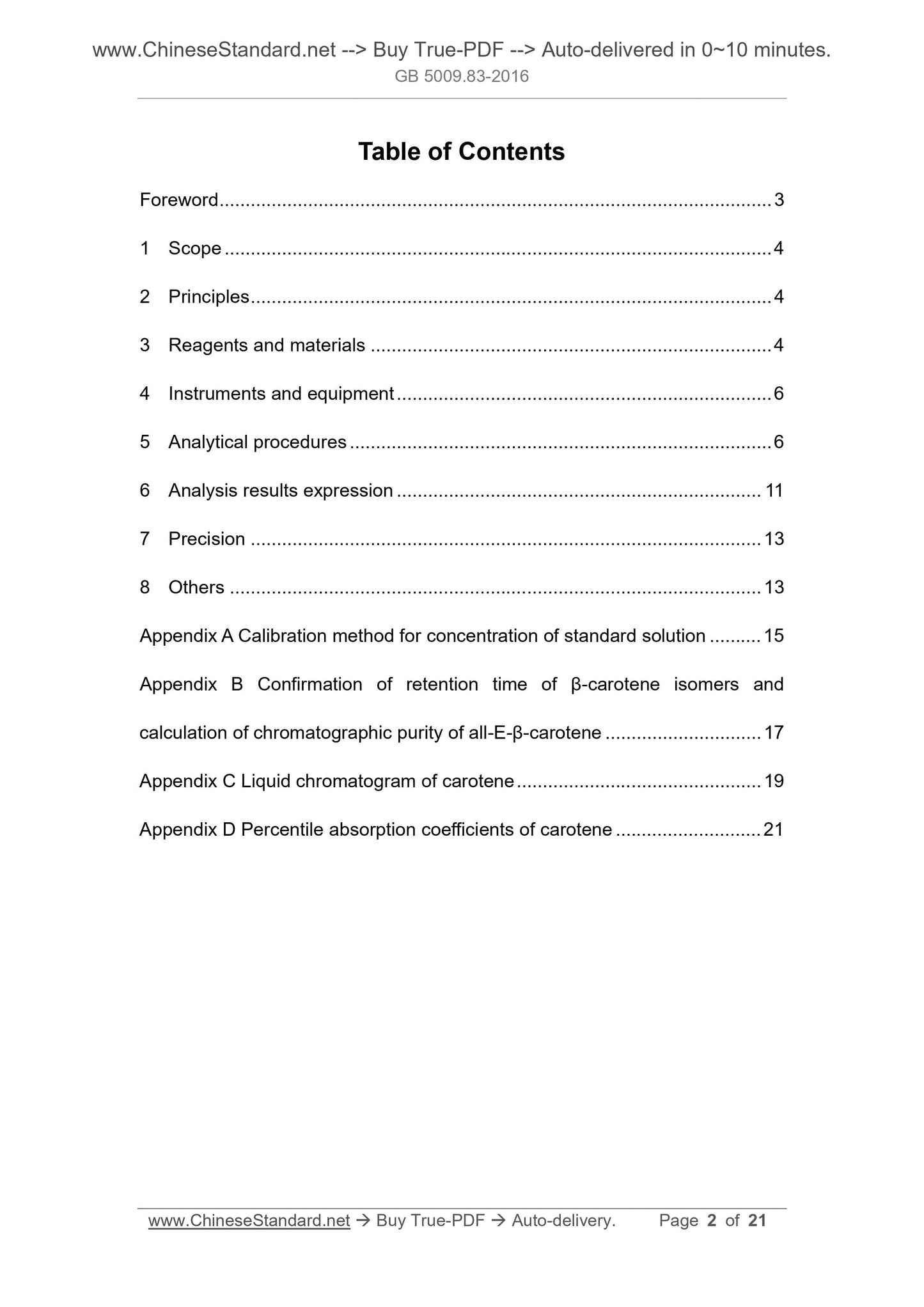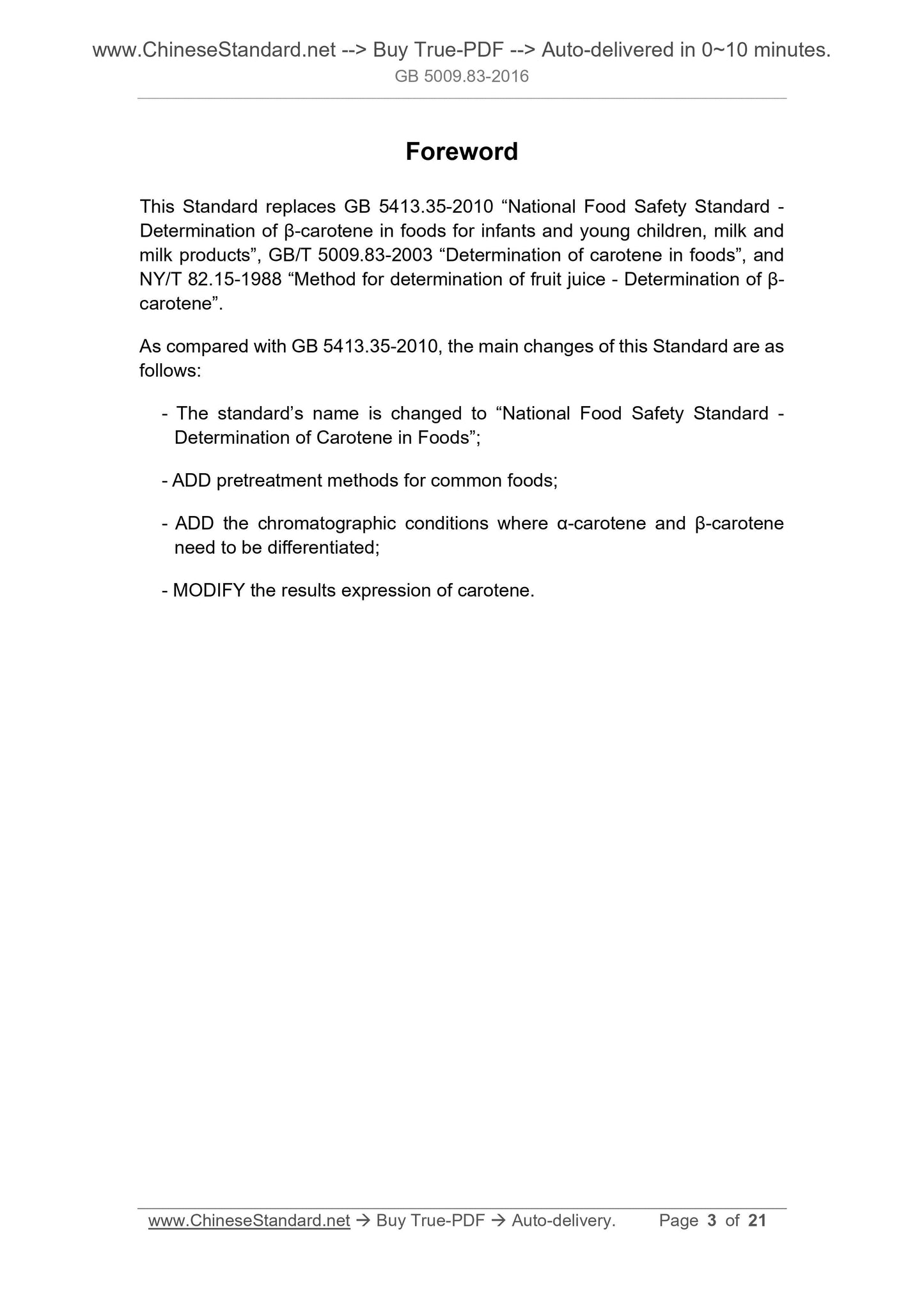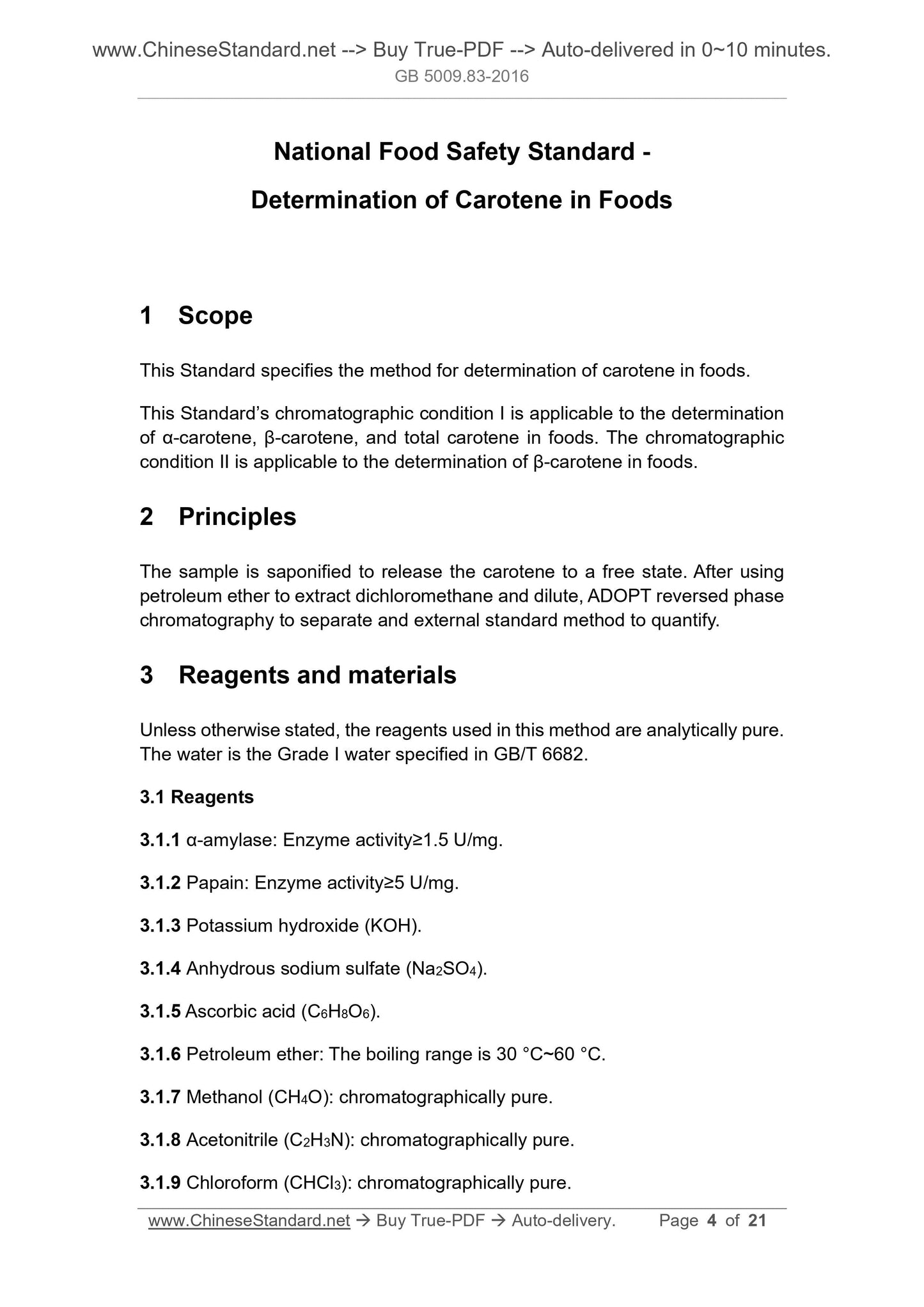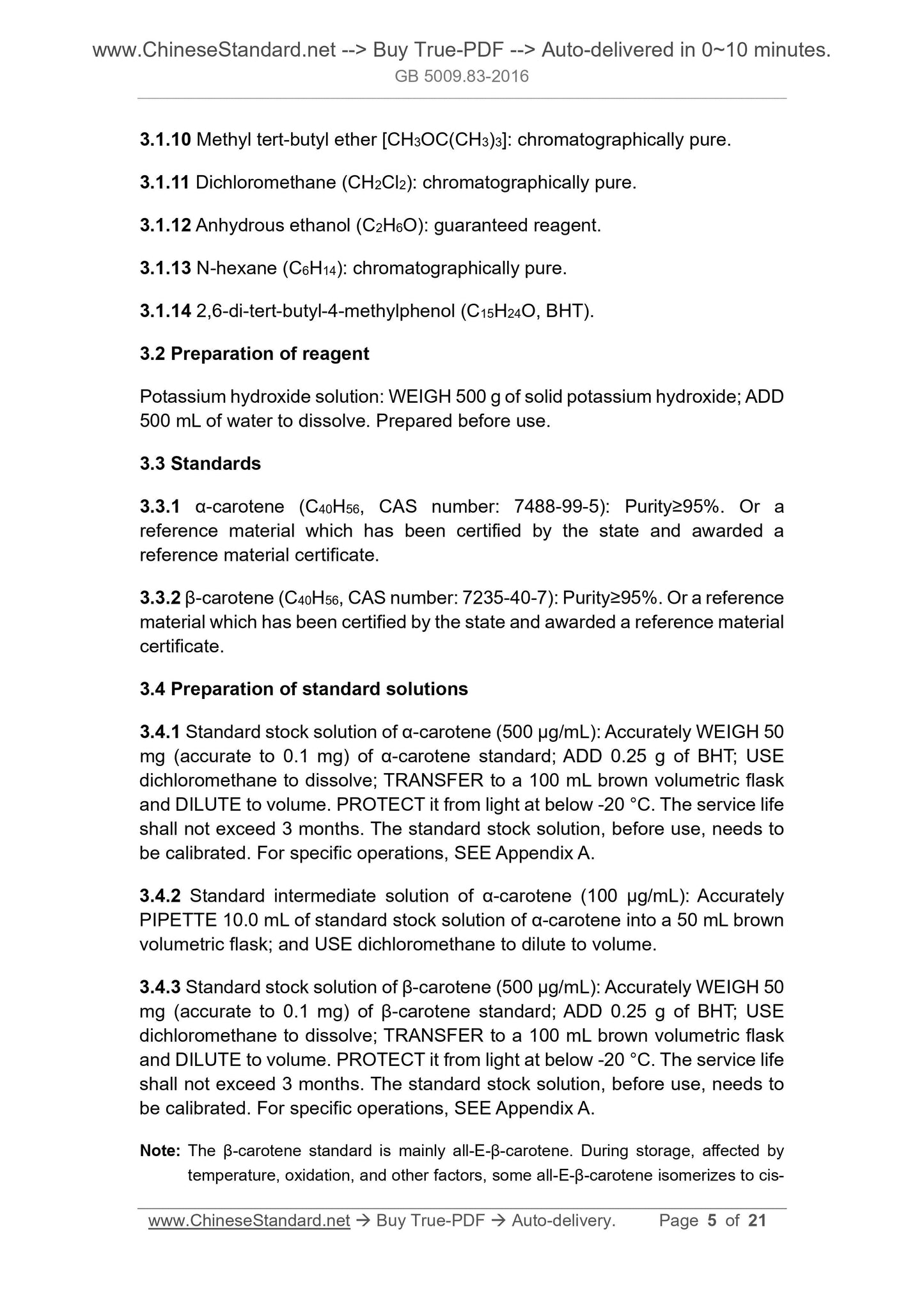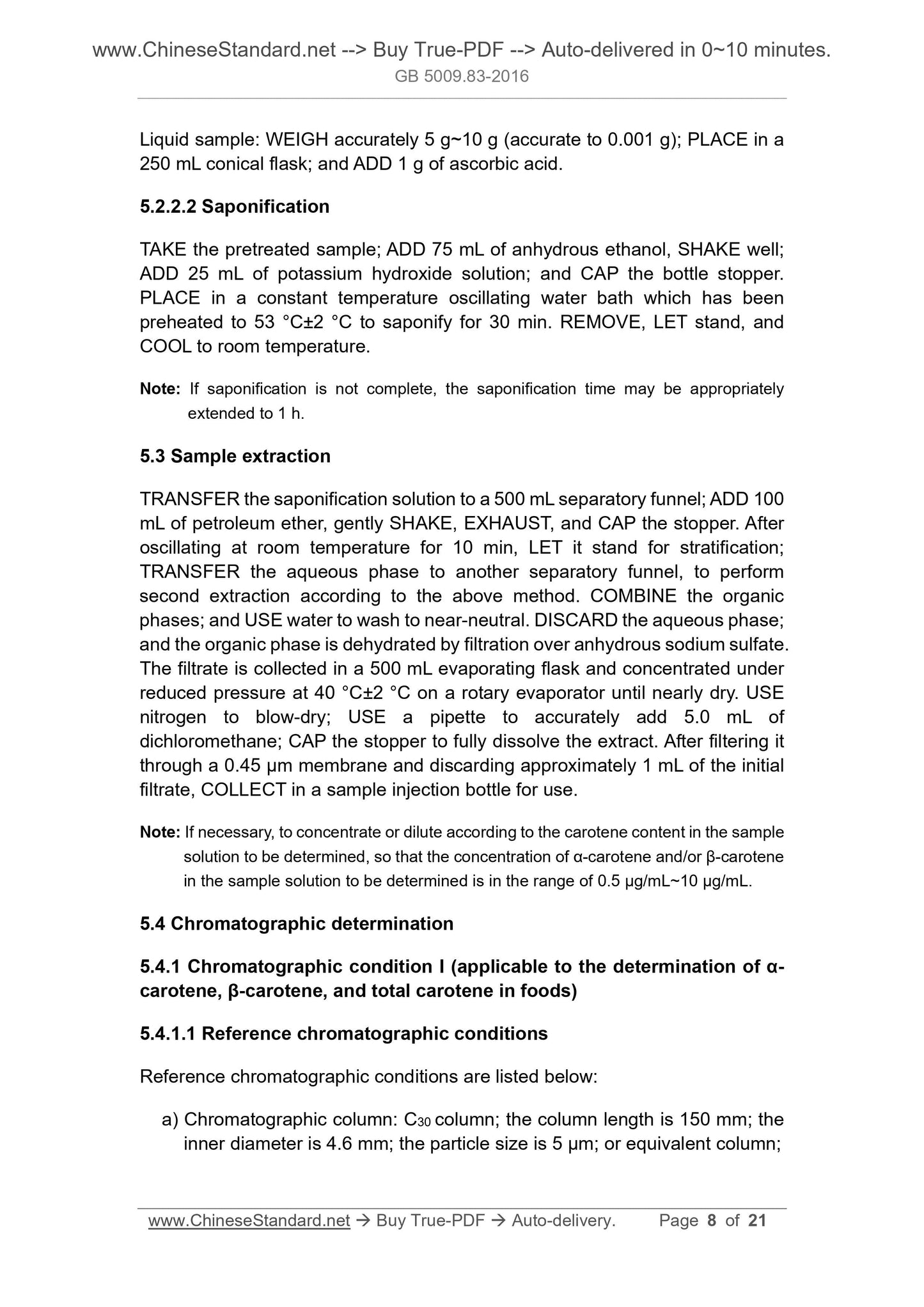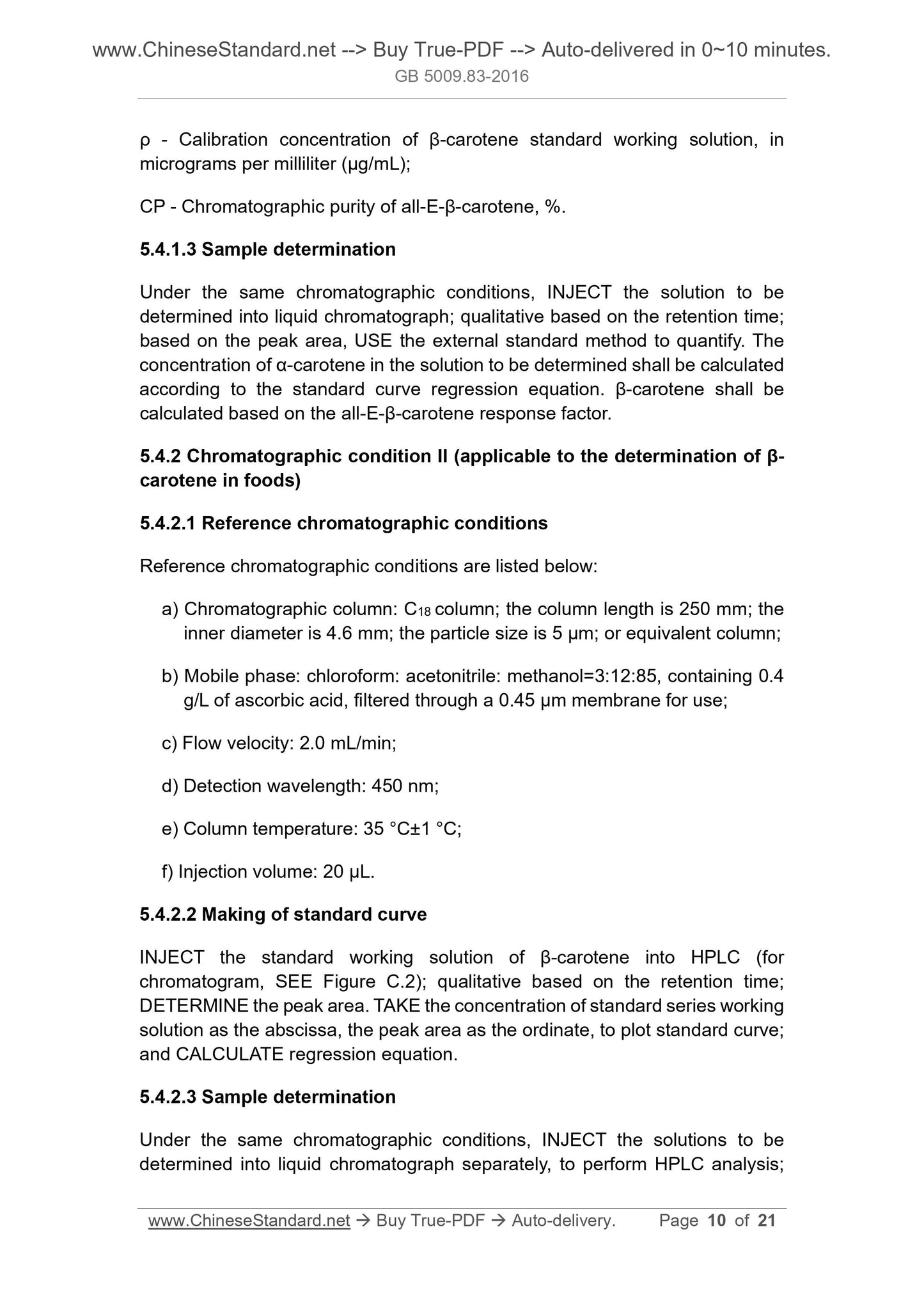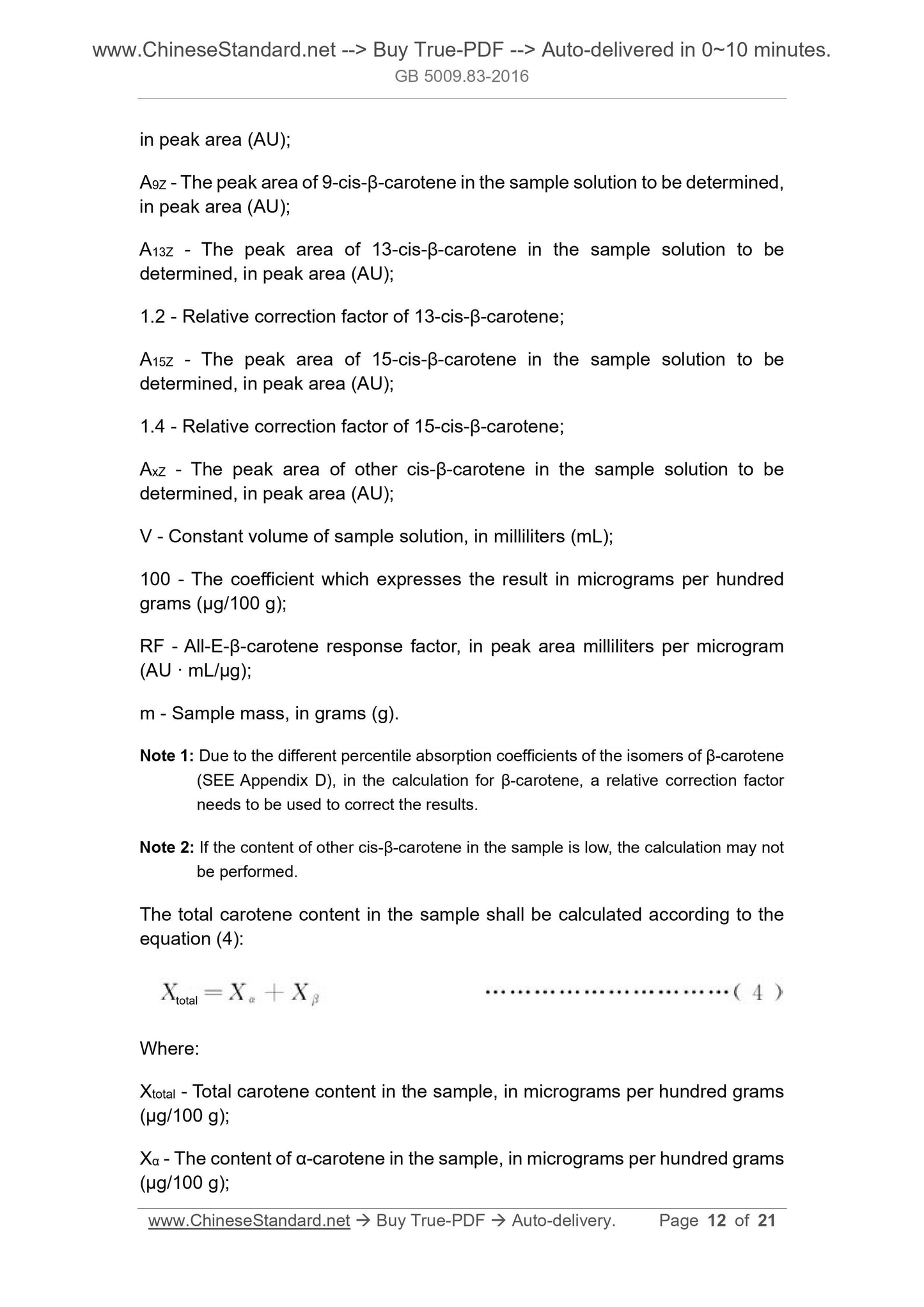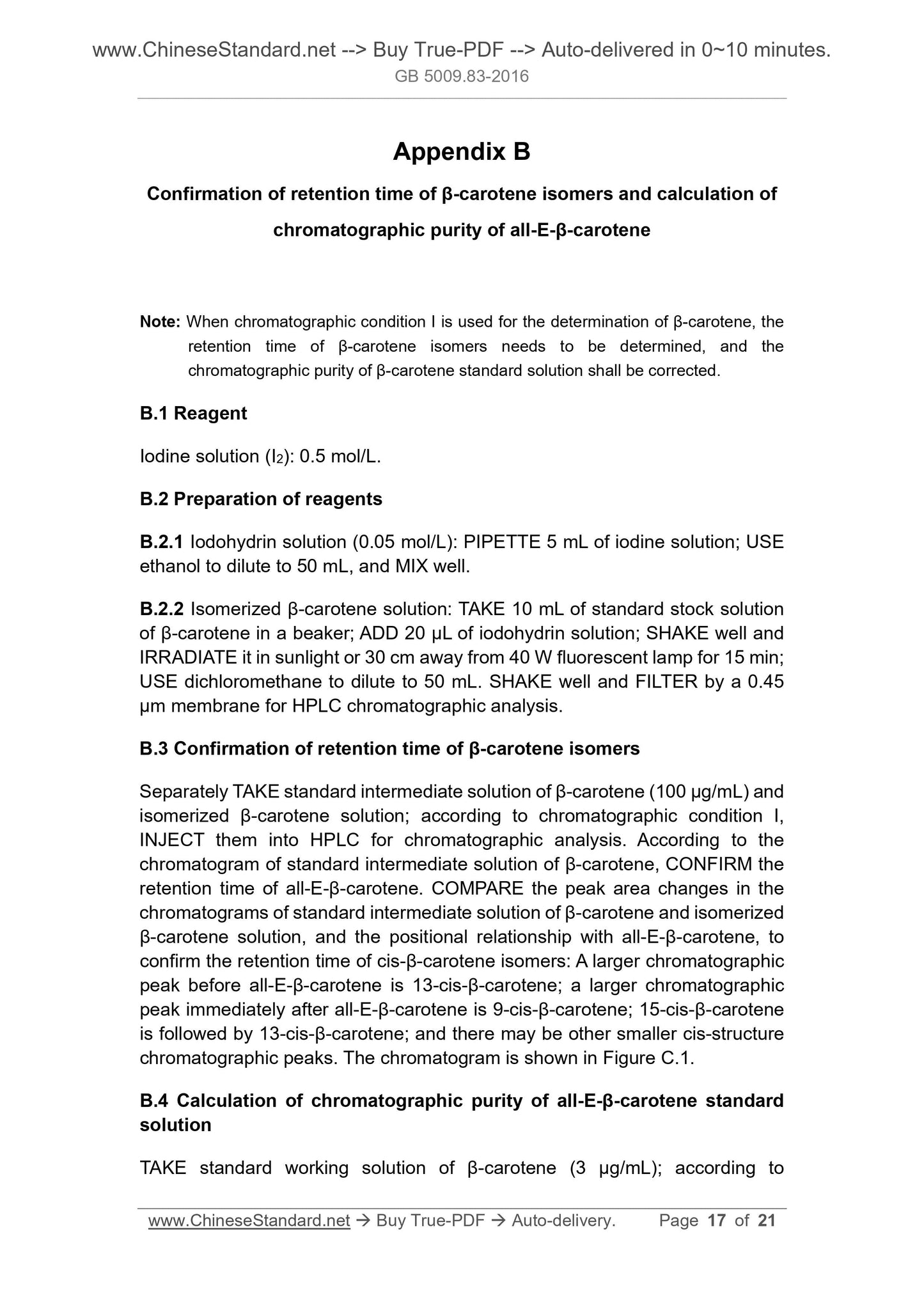1
/
of
9
www.ChineseStandard.us -- Field Test Asia Pte. Ltd.
GB 5009.83-2016 English PDF
GB 5009.83-2016 English PDF
Regular price
$85.00
Regular price
Sale price
$85.00
Unit price
/
per
Shipping calculated at checkout.
Couldn't load pickup availability
GB 5009.83-2016: National food safety standard - Determination of Carotene in Foods
Delivery: 9 seconds. Download (& Email) true-PDF + Invoice.
Get Quotation: Click GB 5009.83-2016 (Self-service in 1-minute)
Historical versions (Master-website): GB 5009.83-2016
Preview True-PDF (Reload/Scroll-down if blank)
GB 5009.83-2016
GB
NATIONAL STANDARD OF THE
PEOPLE’S REPUBLIC OF CHINA
National Food Safety Standard -
Determination of Carotene in Foods
ISSUED ON. DECEMBER 23, 2016
IMPLEMENTED ON. JUNE 23, 2017
Issued by. National Health and Family Planning Commission of the PRC;
China Food and Drug Administration.
Table of Contents
Foreword ... 3
1 Scope ... 4
2 Principles ... 4
3 Reagents and materials ... 4
4 Instruments and equipment ... 6
5 Analytical procedures ... 6
6 Analysis results expression ... 11
7 Precision ... 13
8 Others ... 13
Appendix A Calibration method for concentration of standard solution ... 15
Appendix B Confirmation of retention time of β-carotene isomers and
calculation of chromatographic purity of all-E-β-carotene ... 17
Appendix C Liquid chromatogram of carotene ... 19
Appendix D Percentile absorption coefficients of carotene ... 21
Foreword
This Standard replaces GB 5413.35-2010 “National Food Safety Standard -
Determination of β-carotene in foods for infants and young children, milk and
milk products”, GB/T 5009.83-2003 “Determination of carotene in foods”, and
NY/T 82.15-1988 “Method for determination of fruit juice - Determination of β-
carotene”.
As compared with GB 5413.35-2010, the main changes of this Standard are as
follows.
- The standard’s name is changed to “National Food Safety Standard -
Determination of Carotene in Foods”;
- ADD pretreatment methods for common foods;
- ADD the chromatographic conditions where α-carotene and β-carotene
need to be differentiated;
- MODIFY the results expression of carotene.
National Food Safety Standard -
Determination of Carotene in Foods
1 Scope
This Standard specifies the method for determination of carotene in foods.
This Standard’s chromatographic condition I is applicable to the determination
of α-carotene, β-carotene, and total carotene in foods. The chromatographic
condition II is applicable to the determination of β-carotene in foods.
2 Principles
The sample is saponified to release the carotene to a free state. After using
petroleum ether to extract dichloromethane and dilute, ADOPT reversed phase
chromatography to separate and external standard method to quantify.
3 Reagents and materials
Unless otherwise stated, the reagents used in this method are analytically pure.
The water is the Grade I water specified in GB/T 6682.
3.1 Reagents
3.1.1 α-amylase. Enzyme activity≥1.5 U/mg.
3.1.2 Papain. Enzyme activity≥5 U/mg.
3.1.3 Potassium hydroxide (KOH).
3.1.4 Anhydrous sodium sulfate (Na2SO4).
3.1.5 Ascorbic acid (C6H8O6).
3.1.6 Petroleum ether. The boiling range is 30 °C~60 °C.
3.1.7 Methanol (CH4O). chromatographically pure.
3.1.8 Acetonitrile (C2H3N). chromatographically pure.
3.1.9 Chloroform (CHCl3). chromatographically pure.
3.1.10 Methyl tert-butyl ether [CH3OC(CH3)3]. chromatographically pure.
3.1.11 Dichloromethane (CH2Cl2). chromatographically pure.
3.1.12 Anhydrous ethanol (C2H6O). guaranteed reagent.
3.1.13 N-hexane (C6H14). chromatographically pure.
3.1.14 2,6-di-tert-butyl-4-methylphenol (C15H24O, BHT).
3.2 Preparation of reagent
Potassium hydroxide solution. WEIGH 500 g of solid potassium hydroxide; ADD
500 mL of water to dissolve. Prepared before use.
3.3 Standards
3.3.1 α-carotene (C40H56, CAS number. 7488-99-5). Purity≥95%. Or a
reference material which has been certified by the state and awarded a
reference material certificate.
3.3.2 β-carotene (C40H56, CAS number. 7235-40-7). Purity≥95%. Or a reference
material which has been certified by the state and awarded a reference material
certificate.
3.4 Preparation of standard solutions
3.4.1 Standard stock solution of α-carotene (500 μg/mL). Accurately WEIGH 50
mg (accurate to 0.1 mg) of α-carotene standard; ADD 0.25 g of BHT; USE
dichloromethane to dissolve; TRANSFER to a 100 mL brown volumetric flask
and DILUTE to volume. PROTECT it from light at below -20 °C. The service life
shall not exceed 3 months. The standard stock solution, before use, needs to
be calibrated. For specific operations, SEE Appendix A.
3.4.2 Standard intermediate solution of α-carotene (100 μg/mL). Accurately
PIPETTE 10.0 mL of standard stock solution of α-carotene into a 50 mL brown
volumetric flask; and USE dichloromethane to dilute to volume.
3.4.3 Standard stock solution of β-carotene (500 μg/mL). Accurately WEIGH 50
mg (accurate to 0.1 mg) of β-carotene standard; ADD 0.25 g of BHT; USE
dichloromethane to dissolve; TRANSFER to a 100 mL brown volumetric flask
and DILUTE to volume. PROTECT it from light at below -20 °C. The service life
shall not exceed 3 months. The standard stock solution, before use, needs to
be calibrated. For specific operations, SEE Appendix A.
Note. The β-carotene standard is mainly all-E-β-carotene. During storage, affected by
temperature, oxidation, and other factors, some all-E-β-carotene isomerizes to cis-
Liquid sample. WEIGH accurately 5 g~10 g (accurate to 0.001 g); PLACE in a
250 mL conical flask; and ADD 1 g of ascorbic acid.
5.2.2.2 Saponification
TAKE the pretreated sample; ADD 75 mL of anhydrous ethanol, SHAKE well;
ADD 25 mL of potassium hydroxide solution; and CAP the bottle stopper.
PLACE in a constant temperature oscillating water bath which has been
preheated to 53 °C±2 °C to saponify for 30 min. REMOVE, LET stand, and
COOL to room temperature.
Note. If saponification is not complete, the saponification time may be appropriately
extended to 1 h.
5.3 Sample extraction
TRANSFER the saponification solution to a 500 mL separatory funnel; ADD 100
mL of petroleum ether, gently SHAKE, EXHAUST, and CAP the stopper. After
oscillating at room temperature for 10 min, LET it stand for stratification;
TRANSFER the aqueous phase to another separatory funnel, to perform
second extraction according to the above method. COMBINE the organic
phases; and USE water to wash to near-neutral. DISCARD the aqueous phase;
and the organic phase is dehydrated by filtration over anhydrous sodium sulfate.
The filtrate is collected in a 500 mL evaporating flask and concentrated under
reduced pressure at 40 °C±2 °C on a rotary evaporator until nearly dry. USE
nitrogen to blow-dry; USE a pipette to accurately add 5.0 mL of
dichloromethane; CAP the stopper to fully dissolve the extract. After filtering it
through a 0.45 μm membrane and discarding approximately 1 mL of the initial
filtrate, COLLECT in a sample injection bottle for use.
Note. If necessary, to concentrate or dilute according to the carotene content in the sample
solution to be determined, so that the concentration of α-carotene and/or β-carotene
in the sample solution to be determined is in the range of 0.5 μg/mL~10 μg/mL.
5.4 Chromatographic determination
5.4.1 Chromatographic condition I (applicable to the determination of α-
carotene, β-carotene, and total carotene in foods)
5.4.1.1 Reference chromatographic conditions
Reference chromatographic conditions are listed below.
a) Chromatographic column. C30 column; the column length is 150 mm; the
inner diameter is 4.6 mm; the particle size is 5 μm; or equivalent column;
ρ - Calibration concentration of β-carotene standard working solution, in
micrograms per milliliter (μg/mL);
CP - Chromatographic purity of all-E-β-carotene, %.
5.4.1.3 Sample determination
Under the same chromatographic conditions, INJECT the solution to be
determined into liquid chromatograph; qualitative based on the retention time;
based on the peak area, USE the external standard method to quantify. The
concentration of α-carotene in the solution to be determined shall be calculated
according to the standard curve regression equation. β-carotene shall be
calculated based on the all-E-β-carotene response factor.
5.4.2 Chromatographic condition II (applicable to the determination of β-
carotene in foods)
5.4.2.1 Reference chromatographic conditions
Reference chromatographic conditions are listed below.
a) Chromatographic column. C18 column; the column length is 250 mm; the
inner diameter is 4.6 mm; the particle size is 5 μm; or equivalent column;
b) Mobile phase. chloroform. acetonitrile. methanol=3.12.85, containing 0.4
g/L of ascorbic acid, filtered through a 0.45 μm membrane for use;
c) Flow velocity. 2.0 mL/min;
d) Detection wavelength. 450 nm;
e) Column temperature. 35 °C±1 °C;
f) Injection volume. 20 μL.
5.4.2.2 Making of standard curve
INJECT the standard working solution of β-carotene into HPLC (for
chromatogram, SEE Figure C.2); qualitative based on the retention time;
DETERMINE the peak area. TAKE the concentration of standard series working
solution as the abscissa, the peak area as the ordinate, to plot standard curve;
and CALCULATE regression equation.
5.4.2.3 Sample determination
Under the same chromatographic conditions, INJECT the solutions to be
determined into liquid chromatograph separately, to perform HPLC analysis;
in peak area (AU);
A9Z - The peak area of 9-cis-β-carotene in the sample solution to be determined,
in peak area (AU);
A13Z - The peak area of 13-cis-β-carotene in the sample solution to be
determined, in peak area (AU);
1.2 - Relative correction factor of 13-cis-β-carotene;
A15Z - The peak area of 15-cis-β-carotene in the sample solution to be
determined, in peak area (AU);
1.4 - Relative correction factor of 15-cis-β-carotene;
AxZ - The peak area of other cis-β-carotene in the sample solution to be
determined, in peak area (AU);
V - Constant volume of sample solution, in milliliters (mL);
100 - The coefficient which expresses the result in micrograms per hundred
grams (μg/100 g);
RF - All-E-β-carotene response factor, in peak area milliliters per microgram
(AU · mL/μg);
m - Sample mass, in grams (g).
Note 1. Due to the different percentile absorption coefficients of the isomers of β-carotene
(SEE Appendix D), in the calculation for β-carotene, a relative correction factor
needs to be used to correct the results.
Note 2. If the content of other cis-β-carotene in the sample is low, the calculation may not
be performed.
The total carotene content in the sample shall be calculated according to the
equation (4).
Where.
Xtotal - Total carotene content in the sample, in micrograms per hundred grams
(μg/100 g);
Xα - The content of α-carotene in the sample, in micrograms per hundred grams
(μg/100 g);
total
Appendix B
Confirmation of retention time of β-carotene isomers and calculation of
chromatographic purity of all-E-β-carotene
Note. When chromatographic condition I is used for the determination of β-carotene, the
retention time of β-carotene isomers needs to be determined, and the
chromatographic purity of β-carotene standard solution shall be corrected.
B.1 Reagent
Iodine solution (I2). 0.5 mol/L.
B.2 Preparation of reagents
B.2.1 Iodohydrin solution (0.05 mol/L). PIPETTE 5 mL of iodine solution; USE
ethanol to dilute to 50 mL, and MIX well.
B.2.2 Isomerized β-carotene solution. TAKE 10 mL of standard stock solution
of β-carotene in a beaker; ADD 20 μL of iodohydrin solution; SHAKE well and
IRRADIATE it in sunlight or 30 cm away from 40 W fluorescent lamp for 15 min;
USE dichloromethane to dilute to 50 mL. SHAKE well and FILTER by a 0.45
μm membrane for HPLC chromatographic analysis.
B.3 Confirmation of retention time of β-carotene isomers
Separately TAKE standard intermediate solution of β-carotene (100 μg/mL) and
isomerized β-carotene solution; according to chromatographic condition I,
INJECT them into HPLC for chromatographic analysis. According to the
chromatogram of standard intermediate solution of β-carotene, CONFIRM the
retention time of all-E-β-carotene. COMPARE the peak area changes in the
chromatograms of standard intermediate solution of β-carotene and isomerized
β-carotene solution, and the positional relationship with all-E-β-carotene, to
confirm the retention time of cis-β-carotene isomers. A larger chromatographic
peak before all-E-β-carotene is 13-cis-β-carotene; a larger chromatographic
peak immediately after all-E-β-carotene is 9-cis-β-carotene; 15-cis-β-carotene
is followed by 13-cis-β-carotene; and there may be other smaller cis-structure
chromatographic peaks. The chromatogram is shown in Figure C.1.
B.4 Calculation of chromatographic purity of all-E-β-carotene standard
solution
TAKE standard working solution of β-carotene (3 μg/mL); according to
GB 5009.83-2016
GB
NATIONAL STANDARD OF THE
PEOPLE’S REPUBLIC OF CHINA
National Food Safety Standard -
Determination of Carotene in Foods
ISSUED ON. DECEMBER 23, 2016
IMPLEMENTED ON. JUNE 23, 2017
Issued by. National Health and Family Planning Commission of the PRC;
China Food and Drug Administration.
Table of Contents
Foreword ... 3
1 Scope ... 4
2 Principles ... 4
3 Reagents and materials ... 4
4 Instruments and equipment ... 6
5 Analytical procedures ... 6
6 Analysis results expression ... 11
7 Precision ... 13
8 Others ... 13
Appendix A Calibration method for concentration of standard solution ... 15
Appendix B Confirmation of retention time of β-carotene isomers and
calculation of chromatographic purity of all-E-β-carotene ... 17
Appendix C Liquid chromatogram of carotene ... 19
Appendix D Percentile absorption coefficients of carotene ... 21
Foreword
This Standard replaces GB 5413.35-2010 “National Food Safety Standard -
Determination of β-carotene in foods for infants and young children, milk and
milk products”, GB/T 5009.83-2003 “Determination of carotene in foods”, and
NY/T 82.15-1988 “Method for determination of fruit juice - Determination of β-
carotene”.
As compared with GB 5413.35-2010, the main changes of this Standard are as
follows.
- The standard’s name is changed to “National Food Safety Standard -
Determination of Carotene in Foods”;
- ADD pretreatment methods for common foods;
- ADD the chromatographic conditions where α-carotene and β...
Delivery: 9 seconds. Download (& Email) true-PDF + Invoice.
Get Quotation: Click GB 5009.83-2016 (Self-service in 1-minute)
Historical versions (Master-website): GB 5009.83-2016
Preview True-PDF (Reload/Scroll-down if blank)
GB 5009.83-2016
GB
NATIONAL STANDARD OF THE
PEOPLE’S REPUBLIC OF CHINA
National Food Safety Standard -
Determination of Carotene in Foods
ISSUED ON. DECEMBER 23, 2016
IMPLEMENTED ON. JUNE 23, 2017
Issued by. National Health and Family Planning Commission of the PRC;
China Food and Drug Administration.
Table of Contents
Foreword ... 3
1 Scope ... 4
2 Principles ... 4
3 Reagents and materials ... 4
4 Instruments and equipment ... 6
5 Analytical procedures ... 6
6 Analysis results expression ... 11
7 Precision ... 13
8 Others ... 13
Appendix A Calibration method for concentration of standard solution ... 15
Appendix B Confirmation of retention time of β-carotene isomers and
calculation of chromatographic purity of all-E-β-carotene ... 17
Appendix C Liquid chromatogram of carotene ... 19
Appendix D Percentile absorption coefficients of carotene ... 21
Foreword
This Standard replaces GB 5413.35-2010 “National Food Safety Standard -
Determination of β-carotene in foods for infants and young children, milk and
milk products”, GB/T 5009.83-2003 “Determination of carotene in foods”, and
NY/T 82.15-1988 “Method for determination of fruit juice - Determination of β-
carotene”.
As compared with GB 5413.35-2010, the main changes of this Standard are as
follows.
- The standard’s name is changed to “National Food Safety Standard -
Determination of Carotene in Foods”;
- ADD pretreatment methods for common foods;
- ADD the chromatographic conditions where α-carotene and β-carotene
need to be differentiated;
- MODIFY the results expression of carotene.
National Food Safety Standard -
Determination of Carotene in Foods
1 Scope
This Standard specifies the method for determination of carotene in foods.
This Standard’s chromatographic condition I is applicable to the determination
of α-carotene, β-carotene, and total carotene in foods. The chromatographic
condition II is applicable to the determination of β-carotene in foods.
2 Principles
The sample is saponified to release the carotene to a free state. After using
petroleum ether to extract dichloromethane and dilute, ADOPT reversed phase
chromatography to separate and external standard method to quantify.
3 Reagents and materials
Unless otherwise stated, the reagents used in this method are analytically pure.
The water is the Grade I water specified in GB/T 6682.
3.1 Reagents
3.1.1 α-amylase. Enzyme activity≥1.5 U/mg.
3.1.2 Papain. Enzyme activity≥5 U/mg.
3.1.3 Potassium hydroxide (KOH).
3.1.4 Anhydrous sodium sulfate (Na2SO4).
3.1.5 Ascorbic acid (C6H8O6).
3.1.6 Petroleum ether. The boiling range is 30 °C~60 °C.
3.1.7 Methanol (CH4O). chromatographically pure.
3.1.8 Acetonitrile (C2H3N). chromatographically pure.
3.1.9 Chloroform (CHCl3). chromatographically pure.
3.1.10 Methyl tert-butyl ether [CH3OC(CH3)3]. chromatographically pure.
3.1.11 Dichloromethane (CH2Cl2). chromatographically pure.
3.1.12 Anhydrous ethanol (C2H6O). guaranteed reagent.
3.1.13 N-hexane (C6H14). chromatographically pure.
3.1.14 2,6-di-tert-butyl-4-methylphenol (C15H24O, BHT).
3.2 Preparation of reagent
Potassium hydroxide solution. WEIGH 500 g of solid potassium hydroxide; ADD
500 mL of water to dissolve. Prepared before use.
3.3 Standards
3.3.1 α-carotene (C40H56, CAS number. 7488-99-5). Purity≥95%. Or a
reference material which has been certified by the state and awarded a
reference material certificate.
3.3.2 β-carotene (C40H56, CAS number. 7235-40-7). Purity≥95%. Or a reference
material which has been certified by the state and awarded a reference material
certificate.
3.4 Preparation of standard solutions
3.4.1 Standard stock solution of α-carotene (500 μg/mL). Accurately WEIGH 50
mg (accurate to 0.1 mg) of α-carotene standard; ADD 0.25 g of BHT; USE
dichloromethane to dissolve; TRANSFER to a 100 mL brown volumetric flask
and DILUTE to volume. PROTECT it from light at below -20 °C. The service life
shall not exceed 3 months. The standard stock solution, before use, needs to
be calibrated. For specific operations, SEE Appendix A.
3.4.2 Standard intermediate solution of α-carotene (100 μg/mL). Accurately
PIPETTE 10.0 mL of standard stock solution of α-carotene into a 50 mL brown
volumetric flask; and USE dichloromethane to dilute to volume.
3.4.3 Standard stock solution of β-carotene (500 μg/mL). Accurately WEIGH 50
mg (accurate to 0.1 mg) of β-carotene standard; ADD 0.25 g of BHT; USE
dichloromethane to dissolve; TRANSFER to a 100 mL brown volumetric flask
and DILUTE to volume. PROTECT it from light at below -20 °C. The service life
shall not exceed 3 months. The standard stock solution, before use, needs to
be calibrated. For specific operations, SEE Appendix A.
Note. The β-carotene standard is mainly all-E-β-carotene. During storage, affected by
temperature, oxidation, and other factors, some all-E-β-carotene isomerizes to cis-
Liquid sample. WEIGH accurately 5 g~10 g (accurate to 0.001 g); PLACE in a
250 mL conical flask; and ADD 1 g of ascorbic acid.
5.2.2.2 Saponification
TAKE the pretreated sample; ADD 75 mL of anhydrous ethanol, SHAKE well;
ADD 25 mL of potassium hydroxide solution; and CAP the bottle stopper.
PLACE in a constant temperature oscillating water bath which has been
preheated to 53 °C±2 °C to saponify for 30 min. REMOVE, LET stand, and
COOL to room temperature.
Note. If saponification is not complete, the saponification time may be appropriately
extended to 1 h.
5.3 Sample extraction
TRANSFER the saponification solution to a 500 mL separatory funnel; ADD 100
mL of petroleum ether, gently SHAKE, EXHAUST, and CAP the stopper. After
oscillating at room temperature for 10 min, LET it stand for stratification;
TRANSFER the aqueous phase to another separatory funnel, to perform
second extraction according to the above method. COMBINE the organic
phases; and USE water to wash to near-neutral. DISCARD the aqueous phase;
and the organic phase is dehydrated by filtration over anhydrous sodium sulfate.
The filtrate is collected in a 500 mL evaporating flask and concentrated under
reduced pressure at 40 °C±2 °C on a rotary evaporator until nearly dry. USE
nitrogen to blow-dry; USE a pipette to accurately add 5.0 mL of
dichloromethane; CAP the stopper to fully dissolve the extract. After filtering it
through a 0.45 μm membrane and discarding approximately 1 mL of the initial
filtrate, COLLECT in a sample injection bottle for use.
Note. If necessary, to concentrate or dilute according to the carotene content in the sample
solution to be determined, so that the concentration of α-carotene and/or β-carotene
in the sample solution to be determined is in the range of 0.5 μg/mL~10 μg/mL.
5.4 Chromatographic determination
5.4.1 Chromatographic condition I (applicable to the determination of α-
carotene, β-carotene, and total carotene in foods)
5.4.1.1 Reference chromatographic conditions
Reference chromatographic conditions are listed below.
a) Chromatographic column. C30 column; the column length is 150 mm; the
inner diameter is 4.6 mm; the particle size is 5 μm; or equivalent column;
ρ - Calibration concentration of β-carotene standard working solution, in
micrograms per milliliter (μg/mL);
CP - Chromatographic purity of all-E-β-carotene, %.
5.4.1.3 Sample determination
Under the same chromatographic conditions, INJECT the solution to be
determined into liquid chromatograph; qualitative based on the retention time;
based on the peak area, USE the external standard method to quantify. The
concentration of α-carotene in the solution to be determined shall be calculated
according to the standard curve regression equation. β-carotene shall be
calculated based on the all-E-β-carotene response factor.
5.4.2 Chromatographic condition II (applicable to the determination of β-
carotene in foods)
5.4.2.1 Reference chromatographic conditions
Reference chromatographic conditions are listed below.
a) Chromatographic column. C18 column; the column length is 250 mm; the
inner diameter is 4.6 mm; the particle size is 5 μm; or equivalent column;
b) Mobile phase. chloroform. acetonitrile. methanol=3.12.85, containing 0.4
g/L of ascorbic acid, filtered through a 0.45 μm membrane for use;
c) Flow velocity. 2.0 mL/min;
d) Detection wavelength. 450 nm;
e) Column temperature. 35 °C±1 °C;
f) Injection volume. 20 μL.
5.4.2.2 Making of standard curve
INJECT the standard working solution of β-carotene into HPLC (for
chromatogram, SEE Figure C.2); qualitative based on the retention time;
DETERMINE the peak area. TAKE the concentration of standard series working
solution as the abscissa, the peak area as the ordinate, to plot standard curve;
and CALCULATE regression equation.
5.4.2.3 Sample determination
Under the same chromatographic conditions, INJECT the solutions to be
determined into liquid chromatograph separately, to perform HPLC analysis;
in peak area (AU);
A9Z - The peak area of 9-cis-β-carotene in the sample solution to be determined,
in peak area (AU);
A13Z - The peak area of 13-cis-β-carotene in the sample solution to be
determined, in peak area (AU);
1.2 - Relative correction factor of 13-cis-β-carotene;
A15Z - The peak area of 15-cis-β-carotene in the sample solution to be
determined, in peak area (AU);
1.4 - Relative correction factor of 15-cis-β-carotene;
AxZ - The peak area of other cis-β-carotene in the sample solution to be
determined, in peak area (AU);
V - Constant volume of sample solution, in milliliters (mL);
100 - The coefficient which expresses the result in micrograms per hundred
grams (μg/100 g);
RF - All-E-β-carotene response factor, in peak area milliliters per microgram
(AU · mL/μg);
m - Sample mass, in grams (g).
Note 1. Due to the different percentile absorption coefficients of the isomers of β-carotene
(SEE Appendix D), in the calculation for β-carotene, a relative correction factor
needs to be used to correct the results.
Note 2. If the content of other cis-β-carotene in the sample is low, the calculation may not
be performed.
The total carotene content in the sample shall be calculated according to the
equation (4).
Where.
Xtotal - Total carotene content in the sample, in micrograms per hundred grams
(μg/100 g);
Xα - The content of α-carotene in the sample, in micrograms per hundred grams
(μg/100 g);
total
Appendix B
Confirmation of retention time of β-carotene isomers and calculation of
chromatographic purity of all-E-β-carotene
Note. When chromatographic condition I is used for the determination of β-carotene, the
retention time of β-carotene isomers needs to be determined, and the
chromatographic purity of β-carotene standard solution shall be corrected.
B.1 Reagent
Iodine solution (I2). 0.5 mol/L.
B.2 Preparation of reagents
B.2.1 Iodohydrin solution (0.05 mol/L). PIPETTE 5 mL of iodine solution; USE
ethanol to dilute to 50 mL, and MIX well.
B.2.2 Isomerized β-carotene solution. TAKE 10 mL of standard stock solution
of β-carotene in a beaker; ADD 20 μL of iodohydrin solution; SHAKE well and
IRRADIATE it in sunlight or 30 cm away from 40 W fluorescent lamp for 15 min;
USE dichloromethane to dilute to 50 mL. SHAKE well and FILTER by a 0.45
μm membrane for HPLC chromatographic analysis.
B.3 Confirmation of retention time of β-carotene isomers
Separately TAKE standard intermediate solution of β-carotene (100 μg/mL) and
isomerized β-carotene solution; according to chromatographic condition I,
INJECT them into HPLC for chromatographic analysis. According to the
chromatogram of standard intermediate solution of β-carotene, CONFIRM the
retention time of all-E-β-carotene. COMPARE the peak area changes in the
chromatograms of standard intermediate solution of β-carotene and isomerized
β-carotene solution, and the positional relationship with all-E-β-carotene, to
confirm the retention time of cis-β-carotene isomers. A larger chromatographic
peak before all-E-β-carotene is 13-cis-β-carotene; a larger chromatographic
peak immediately after all-E-β-carotene is 9-cis-β-carotene; 15-cis-β-carotene
is followed by 13-cis-β-carotene; and there may be other smaller cis-structure
chromatographic peaks. The chromatogram is shown in Figure C.1.
B.4 Calculation of chromatographic purity of all-E-β-carotene standard
solution
TAKE standard working solution of β-carotene (3 μg/mL); according to
GB 5009.83-2016
GB
NATIONAL STANDARD OF THE
PEOPLE’S REPUBLIC OF CHINA
National Food Safety Standard -
Determination of Carotene in Foods
ISSUED ON. DECEMBER 23, 2016
IMPLEMENTED ON. JUNE 23, 2017
Issued by. National Health and Family Planning Commission of the PRC;
China Food and Drug Administration.
Table of Contents
Foreword ... 3
1 Scope ... 4
2 Principles ... 4
3 Reagents and materials ... 4
4 Instruments and equipment ... 6
5 Analytical procedures ... 6
6 Analysis results expression ... 11
7 Precision ... 13
8 Others ... 13
Appendix A Calibration method for concentration of standard solution ... 15
Appendix B Confirmation of retention time of β-carotene isomers and
calculation of chromatographic purity of all-E-β-carotene ... 17
Appendix C Liquid chromatogram of carotene ... 19
Appendix D Percentile absorption coefficients of carotene ... 21
Foreword
This Standard replaces GB 5413.35-2010 “National Food Safety Standard -
Determination of β-carotene in foods for infants and young children, milk and
milk products”, GB/T 5009.83-2003 “Determination of carotene in foods”, and
NY/T 82.15-1988 “Method for determination of fruit juice - Determination of β-
carotene”.
As compared with GB 5413.35-2010, the main changes of this Standard are as
follows.
- The standard’s name is changed to “National Food Safety Standard -
Determination of Carotene in Foods”;
- ADD pretreatment methods for common foods;
- ADD the chromatographic conditions where α-carotene and β...
Share
